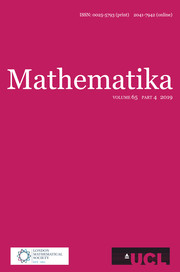Article contents
On extensions generated by roots of lifting polynomials
Published online by Cambridge University Press: 26 February 2010
Abstract
Let v be a Henselian valuation of any rank of a field K and  its unique prolongation to a fixed algebraic closure
its unique prolongation to a fixed algebraic closure  of K having value group
of K having value group  . For any subfield L of
. For any subfield L of  , let R(L) denote the residue field of the valuation obtained by restricting
, let R(L) denote the residue field of the valuation obtained by restricting  to L. Using the canonical homomorphism from the valuation ring of v onto its residue field R(K), one can lift any monic irreducible polynomial with coefficients in R(K) to yield a monic irreducible polynomial with coefficients in K. In an attempt to generalize this concept, Popescu and Zaharescu introduced the notion of lifting with respect to a (K, v)-minimal pair (α, δ) belonging to
to L. Using the canonical homomorphism from the valuation ring of v onto its residue field R(K), one can lift any monic irreducible polynomial with coefficients in R(K) to yield a monic irreducible polynomial with coefficients in K. In an attempt to generalize this concept, Popescu and Zaharescu introduced the notion of lifting with respect to a (K, v)-minimal pair (α, δ) belonging to  ×
×  . As in the case of usual lifting, a given monic irreducible polynomial Q(y) belonging to R(K(α))[y] gives rise to several monic irreducible polynomials over K which are obtained by lifting with respect to a fixed (K, v)-minimal pair (α, δ). If F, F1 are two such lifted polynomials with coefficients in K having roots θ, θ1, respectively, then it is proved in the present paper that
. As in the case of usual lifting, a given monic irreducible polynomial Q(y) belonging to R(K(α))[y] gives rise to several monic irreducible polynomials over K which are obtained by lifting with respect to a fixed (K, v)-minimal pair (α, δ). If F, F1 are two such lifted polynomials with coefficients in K having roots θ, θ1, respectively, then it is proved in the present paper that  in case (K, v) is a tame field, it is shown that K(θ) and K(θ1) are indeed K-isomorphic.
in case (K, v) is a tame field, it is shown that K(θ) and K(θ1) are indeed K-isomorphic.
MSC classification
Information
- Type
- Research Article
- Information
- Copyright
- Copyright © University College London 2002
References
- 6
- Cited by

